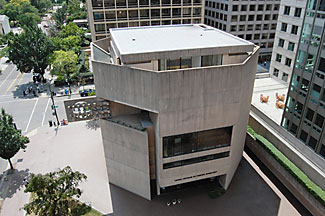Building regulations (including historic preservation), religious freedom, and local and federal laws

Brutalist’ style: Members hope to replace this modernist building near the White House with a more welcoming church. Robert Frazier/The Christian Science Monitor
Awhile back, Congress passed a law, the Religious Land Use and Institutionalized Persons Act of 2000 that creates great opportunities for mischief at the local level. Too often it is interpreted as allowing churches an exemption from local building regulations.
Today's Christian Science Monitor has a story, "'Historic' building versus religious rights" about the debacle around the Third Church of Christ, Scientist in DC, and their opposition to the designation of their building as a historic landmark, which likely puts a crimp in their ability to redevelop the site. The Church claims economic hardship which they argue violates their right to freedom of religion.
The Daily Record of Baltimore is a Monday through Friday legal newspaper that isn't normally available for free online, but one of their articles, on the holding in a similar matter, is online through the American Planning Association's listing of planning articles, "Denial of variances not a violation of RLUIPA." It's worth reading as it makes very clear the distinctions in the law.
The problem with the RLUIPA law is that it is interpreted in many different ways, depending on the state and local courts, and the various federal circuit courts as well, rather than just one way. For an "absolutist" like me, I argue that since building regulations are applied equally to all parties, it is very rare that an RLUIPA challenge should be sustained. That's not how it works in practice though.
-------
My opinion... I believe in the sanctity of the historic preservation law in DC. At the same time, I believe that there are (rare) instances where special merit arguments can be made, allowing for the demolition of historic buildings and their replacement. It's rare that I would support a special merit application, but this is probably one of them. I believe that urban design improvements likely would result from a change to the land use program on this site, and that would be a positive contribution outweighing the saving of this building.
That being said, the process of determining special merit is separate from the original determination of historic merit and subsequent landmarking. And it has nothing to do with whether or not a property is owned by a church. For various reasons, mostly based on poor management of properties by various churches in the City of Washington, a blanket exception for churches from the enforcement of building regulations, including historic preservation protections, is not justifiable, and even the consideration of such an action is poor public policy.
Labels: building regulation, historic preservation, land use planning, law and the legal process, zoning



0 Comments:
Post a Comment
<< Home